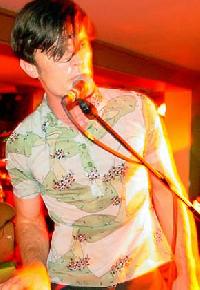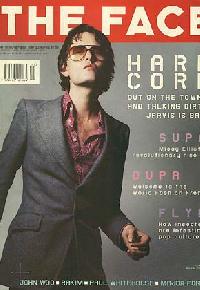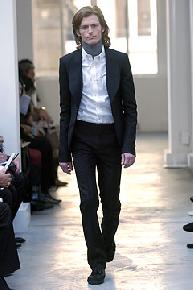A swinging look back at the history of the Mod movement - and those responsible for those happening clothes.
SWINGING SIXTIES
Mod,
as you might have realized, comes from Mod-ern. This trends main
targets were the Euopean teenagers living in a place just recovered
from the second Great War; more than wealthy youngsters, the British
were launching their manifesto in pop culture.
Boutiques then
became a youth camp. Mary Quant uniformed the London Look (mini-skirt
and coloured stockings) in her Baazar store, at Kings Road in London.
Andr Courrges, who claims the credit as the mini creator, launched his
brand in 1961, after a 12-year partnership with Balenciaga. Jean Muir
opened Jane & Jane the same year, while Ossie Clark took over the
design department at Quorum Store in 66 and Ben Sherman
(http://www.bensherman.co.uk) dressed the Beatles in his Carnaby Street
shop. New York, scenting the hype, launched its Paraphernalia in 1965.

METROSEXUAL
In
mens fashion, the Mod movement represented one of its most optimistic
faces. Narrowed tailoring suits and Op Art patterned shirts got
attention even (or should we say, mainly?) of the most conservative
boys in town. Rock icons were the most significant representatives, and
their influences extended for decades. Paul Weller and The Jam were the
coolest in the late 70s. In the mid-90s the Mod revival came with
another name: Cool Britania. The United Kindom was the spot again and
Jarvis Cocker (Pulp) was the hero of moderns Liam Gallaghers haircut
was the most copied, though. Franz Ferdinand's Scottish lads are the
old world response for the Strokes rocker scene.

SCOOTERS AND CINEMA
On
the big screen, Sting hung about on his scooter playing Ace-Faces role,
in Quadrophenia released in '73 by The Who integrants. Afterwards, a
band, a pub and a streetwear line (http://www.lambrettaclothing.co.uk/)
were inspired by Lambretta and its target logo. The Cool World (63) put
British directors and cameramen on the streets, filming sharply dressed
girls and boys. Mod Squad (68-73 and a remake in 99 with Claire Danes)
brought the same idea to television, reforming the trios wardrobe and
intentions.
CATWALK
According to Paris and Milan mens
collections, Mod culture is still on course. Miucha Pradas Miu-Miu,
Nicolas Ghesqieres Balenciaga and Hedi Slimanes Dior Homme are the
tailoring darlings, keeping on the flame through the years. The
extra-neat silhouette is brushed with glaring colours: Sir Paul Smith
(http://www.paulsmith.co.uk) has the most shocking colour palette.
Alexander McQueen, who started at 16 working for a Savile Rows tailor,
wants to design for men as well. This is the return of super-smartness,
states Nick Sullivan, from GQ.

CELEBRATION
Celebrating
the 40 years of Mod Age, Modstock 2004
(http://www.newuntouchables.com/) gathered bands and aficionados last
28 to 30 of May, at Rocket Club, Halloway, in northern London. The
events main attraction was the exhibition of Ready Steady Sew, a
documetary focused on Mod style from the Soho tailors at the end of 50s
until the funny boutique time of the 60s. A Bibas exibition happened in
the same place a thematic fashion show took part.
SWINGING SIXTIES
Mod,
as you might have realized, comes from Mod-ern. This trends main
targets were the Euopean teenagers living in a place just recovered
from the second Great War; more than wealthy youngsters, the British
were launching their manifesto in pop culture.
Boutiques then
became a youth camp. Mary Quant uniformed the London Look (mini-skirt
and coloured stockings) in her Baazar store, at Kings Road in London.
Andr Courrges, who claims the credit as the mini creator, launched his
brand in 1961, after a 12-year partnership with Balenciaga. Jean Muir
opened Jane & Jane the same year, while Ossie Clark took over the
design department at Quorum Store in 66 and Ben Sherman
(http://www.bensherman.co.uk) dressed the Beatles in his Carnaby Street
shop. New York, scenting the hype, launched its Paraphernalia in 1965.

METROSEXUAL
In
mens fashion, the Mod movement represented one of its most optimistic
faces. Narrowed tailoring suits and Op Art patterned shirts got
attention even (or should we say, mainly?) of the most conservative
boys in town. Rock icons were the most significant representatives, and
their influences extended for decades. Paul Weller and The Jam were the
coolest in the late 70s. In the mid-90s the Mod revival came with
another name: Cool Britania. The United Kindom was the spot again and
Jarvis Cocker (Pulp) was the hero of moderns Liam Gallaghers haircut
was the most copied, though. Franz Ferdinand's Scottish lads are the
old world response for the Strokes rocker scene.

SCOOTERS AND CINEMA
On
the big screen, Sting hung about on his scooter playing Ace-Faces role,
in Quadrophenia released in '73 by The Who integrants. Afterwards, a
band, a pub and a streetwear line (http://www.lambrettaclothing.co.uk/)
were inspired by Lambretta and its target logo. The Cool World (63) put
British directors and cameramen on the streets, filming sharply dressed
girls and boys. Mod Squad (68-73 and a remake in 99 with Claire Danes)
brought the same idea to television, reforming the trios wardrobe and
intentions.
CATWALK
According to Paris and Milan mens
collections, Mod culture is still on course. Miucha Pradas Miu-Miu,
Nicolas Ghesqieres Balenciaga and Hedi Slimanes Dior Homme are the
tailoring darlings, keeping on the flame through the years. The
extra-neat silhouette is brushed with glaring colours: Sir Paul Smith
(http://www.paulsmith.co.uk) has the most shocking colour palette.
Alexander McQueen, who started at 16 working for a Savile Rows tailor,
wants to design for men as well. This is the return of super-smartness,
states Nick Sullivan, from GQ.

CELEBRATION
Celebrating
the 40 years of Mod Age, Modstock 2004
(http://www.newuntouchables.com/) gathered bands and aficionados last
28 to 30 of May, at Rocket Club, Halloway, in northern London. The
events main attraction was the exhibition of Ready Steady Sew, a
documetary focused on Mod style from the Soho tailors at the end of 50s
until the funny boutique time of the 60s. A Bibas exibition happened in
the same place a thematic fashion show took part.
|
|


